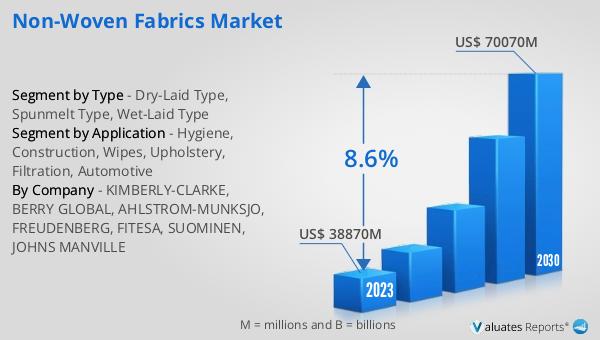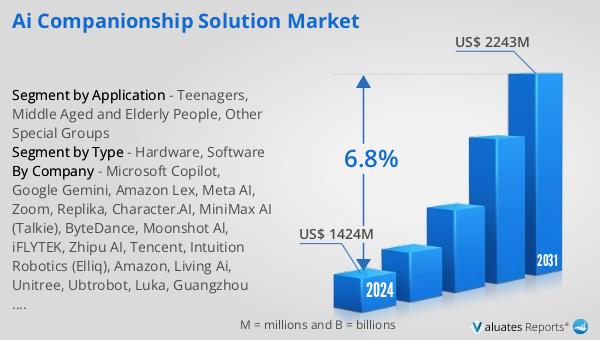What is Global Non-woven Fabrics Market?
The Global Non-woven Fabrics Market is a vast and dynamic sector that plays a crucial role in various industries worldwide. At its core, non-woven fabrics are engineered fabrics that may be a single-use fabric or a very durable fabric. They are not woven or knitted from threads but are made from separate fibers that are bonded together through chemical, heat, or mechanical processes. This market is significant due to its diverse applications, ranging from hygiene products like diapers and wipes to medical supplies, filters, and even construction materials. As of 2023, the market's value stood impressively at US$ 38,870 million, showcasing the immense demand and reliance industries have on these versatile materials. The forecast suggests a promising growth trajectory, with expectations to surge to US$ 70,070 million by 2030, marking an annual growth rate of 8.6%. This growth is driven by the continuous innovation in non-woven fabric technologies, expanding applications, and increasing awareness of the benefits of non-woven fabrics over traditional materials. The market is competitive, with the top five companies holding about 22% of the market share, indicating a relatively fragmented market with ample room for new entrants and innovations.

Dry-Laid Type, Spunmelt Type, Wet-Laid Type in the Global Non-woven Fabrics Market:
Diving into the specifics, the Global Non-woven Fabrics Market is segmented into three primary types based on the manufacturing process: Dry-Laid, Spunmelt, and Wet-Laid. Dry-Laid non-woven fabrics are created through a process where fibers are laid down in a web or mat and then bonded by mechanical, thermal, or chemical means. This type is widely used due to its versatility and cost-effectiveness in producing materials for filters, hygiene products, and insulation. Spunmelt non-woven fabrics, on the other hand, are produced by melting a polymer, spinning it into continuous filaments, and then laying it into a web which is then bonded. This type is particularly favored for its strength and durability, making it ideal for use in medical disposables, protective clothing, and agriculture. Lastly, Wet-Laid non-woven fabrics involve dispersing fibers in a water medium before arranging them into a web and bonding. This process is akin to papermaking and is preferred for its ability to produce very fine and uniform fabrics, suitable for applications in filtration and wipes. Each of these types offers unique properties and advantages, catering to the diverse needs of the industries they serve, and contributing significantly to the market's growth and evolution.
Hygiene, Construction, Wipes, Upholstery, Filtration, Automotive in the Global Non-woven Fabrics Market:
The usage of Global Non-woven Fabrics across various sectors such as Hygiene, Construction, Wipes, Upholstery, Filtration, and Automotive, underscores their versatility and essential role in modern industry. In the hygiene sector, non-woven fabrics are indispensable for producing diapers, feminine hygiene products, and adult incontinence items, offering superior comfort and absorbency. The construction industry benefits from their use in roofing materials, insulation, and geotextiles, where their durability and resistance to elements are crucial. Wipes, both personal care and industrial, rely on non-woven fabrics for their softness and strength, making them ideal for cleaning applications. Upholstery uses these fabrics for their texture and flexibility, enhancing the aesthetic and comfort of furniture. In filtration, non-woven fabrics' ability to trap particles makes them perfect for air and liquid filters, contributing to cleaner environments and processes. Lastly, the automotive sector incorporates non-woven fabrics in interiors, insulation, and even in filtration systems, for their noise reduction and lightweight properties. This wide-ranging applicability not only drives the demand for non-woven fabrics but also pushes the boundaries of innovation within the market, ensuring continuous growth and development in these sectors.
Global Non-woven Fabrics Market Outlook:
The market outlook for Global Non-woven Fabrics presents a promising future, with the market's valuation at US$ 38,870 million in 2023, and an expected rise to US$ 70,070 million by 2030. This projection indicates a robust Compound Annual Growth Rate (CAGR) of 8.6% during the forecast period from 2024 to 2030. Such growth is indicative of the increasing reliance on and demand for non-woven fabrics across various industries, driven by their versatility, efficiency, and innovation in applications. The competitive landscape shows that the top five companies command about 22% of the market share, highlighting a competitive yet fragmented market environment. This scenario suggests ample opportunities for growth, innovation, and market entry for new players, which could further propel the market forward. The anticipated growth underscores the significant role non-woven fabrics play in modern industry and their potential for future applications and technological advancements.
| Report Metric | Details |
| Report Name | Non-woven Fabrics Market |
| Accounted market size in 2023 | US$ 38870 million |
| Forecasted market size in 2030 | US$ 70070 million |
| CAGR | 8.6% |
| Base Year | 2023 |
| Forecasted years | 2024 - 2030 |
| Segment by Type |
|
| Segment by Application |
|
| Production by Region |
|
| Consumption by Region |
|
| By Company | KIMBERLY-CLARKE, BERRY GLOBAL, AHLSTROM-MUNKSJO, FREUDENBERG, FITESA, SUOMINEN, JOHNS MANVILLE |
| Forecast units | USD million in value |
| Report coverage | Revenue and volume forecast, company share, competitive landscape, growth factors and trends |
